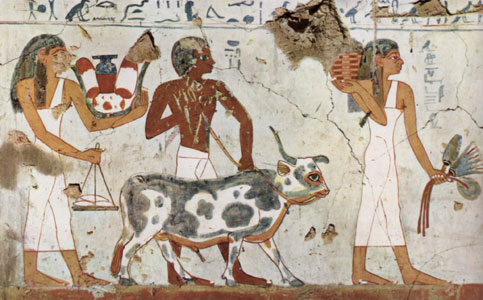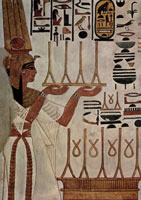Although we now associate fine cotton with Egypt, the ancient Egyptians did not cultivate that crop (although they did trade it with the Romans). Instead, they used linen (mnkht), made from the stem of the flax plant. Cloth was generally woven by women, who could sell whatever excess cloth they could make. Weaving was a highly valued skill associated with the ancient goddess Neith, and a skilled weaver could even be paid in gold. By the New Kingdom the Egyptians had developed vertical looms which required more physical strength, and so many men also became weavers. Silk first came to Egypt during the Ptolemaic Period and was a favourite of the famous Cleopatra.

During the Old Kingdom men and women largely wore simple white garments. Daily dress was a simple rectangular piece of linen wrapped around the body and tucked in at the waste, but many manual workers and poorer men worked naked. Wealthy men wore a short kilt which was sometimes pleated and a shoulder cape. By the Middle Kingdom, men’s kilts had become longer and more complex and ornamental pendants were often attached to elaborate belts. The double kilt was introduced (a triangular loincloth was worn under a more standard kilt) and many men also wore a sleeveless shirt held in place with a belt. Both men and women used linen (and occasionally woolen shawls) and cloaks to deal with the chill of night time.

Ancient Egyptian women often wore the plain white gown or sheath dress commonly depicted in ancient Egyptian art. The gown hugged the body from the ankles to just underneath the breasts, and was held up by one or two decorative shoulder straps. This dress is generally depicted as being skin-tight, but may well have been looser in reality, as this would have been very restrictive. Though white was by far the most predominant colour, coloured threads were sometimes woven into cloth to make stripes.

Women and men also wore a robe that Herodotus called the “kalasaris”. This garment was essentially a rectangle with a hole in the center (through which the wearer placed his or her head) folded in half and sewn together. It could be draped over one or both shoulders or worn with one or two shoulder straps. Some had sleeves while others did not. The garment could start at the neck, or below the breast, but generally included a long skirt which touched the ankles. They were usually worn with a belt which held together the folds of cloth (as worn by Nefertari in the image above).
Some women, such as dancing girls and servants, went naked other than their jewellery. Sometimes they wore delicately beaded pieces which left very little to the imagination. Children also tended to go naked.

A man’s status was confirmed by how elaborate his kilt was, and how fine the linen used to make it. The kilts of the rich nobles and Pharaohs were often very intricately pleated, and must have been difficult to care for.
Kings, queens, and gods are often depicted in colourfully embroidered linen. The ancient Egyptians also added beading to their clothes, and dyed leather to create colourful shoes and belts. Nets of beads were sometimes worn over women’s dresses and beadwork was used to decorates men’s kilts. However, most of the clothing that has been recovered from tombs resembles the long sleeved “galabiyya” favoured by modern Egyptians, rather than the tight fitting or pleated robes shown in paintings and reliefs.

The pharaoh wore a different type of kilt for official duties. This was a half-pleated kilt wound counter-clockwise around the body with a pleated section drawn to the front. The finest “royal linen” was almost diaphanous, and much softer and whiter than other linen. Members of the Royal Family also wore a number of different headdresses and crowns.
Priests were generally only permitted to wear linen clothing and white papyrus sandals when tending a god (neither leather nor wool were considered to be ritually pure). From the Old Kingdom Sem (mortuary) priests wore a leopard skin over their linen clothing which was held in position by a strap over one shoulder.
Copyright J Hill 2010